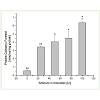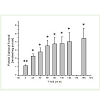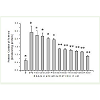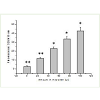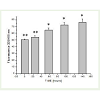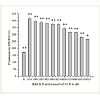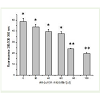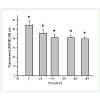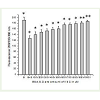Research Article
In vitro Oxidative Damage of Protein byCarbonated Soft Drink and its Restoration by Vitamin C
Pamela Banerjee*, Aniruddha Mukhopadhyay
Department of Environmental Science, University of Calcutta, 35 Ballygunge Circular Road, Kolkata-700019, India
Corresponding author: Pamela Banerjee, Department of Environmental Science, University of Calcutta, 35 BallygungeCircular Road, Kolkata-700019, India, Tel: +919830915163; E-mail: pbanerjee232@gmail.com
Citation: Fombang EN, Agamou JAA, Mbofung CMF. Incorporation of Ricinodendron heudolotti Meal into Blends of Wheat and Precooked Taro Flour for Production of Nutrient Dense Biscuits. Indian J Nutri. 2016;3(2): 131.
Copyright © 2016 Banerjee P,et al. This is an open access article distributed under the Creative Commons Attribution License, which permits unrestricted use, distribution, and reproduction in any medium, provided the original work is properly cited.
Indian Journal of Nutrition | ISSN: 2395-2326 | Volume: 3, Issue: 1
Submission: 06/07/2016; Accepted: 21/07/2016; Published: 01/08/2016
Abstract
Carbonated soft drink causes oxidative damage of liver, kidney and serum proteins with apoptosis of these tissues in guinea pigs. Protein carbonyl and bityrosin formation and tryptophan loss took place under such condition indicating protein oxidation. In in vivo experiments these damages could be prevented by supplementation of Vitamin C to carbonated soft drink fed to guinea pigs. The present study was aimed at weather vitamin C can inhibit protein oxidation in vitro caused by carbonated soft drink when added in both dose and time dependent manner to pure protein solution.
Keywords: Oxidative damage; Carbonated soft drinks
Introduction
Carbonated soft drink have their extreme influence in world’s consumer market and are now almost a part of our daily food habit[1]. The main active ingredients in these drinks are carbonatedwater, high sugar or fructose corn syrup, phosphoric acid, caramelcolour, natural flavour and caffeine [2]. Excess sugar consumptionincreases production of destructive free radicals and lower levelof key antioxidants as reported by [3]. Type II diabetes resultingfrom high sugar consumption is also associated with an increase infree radical generation, leading to damage of proteins and DNA[4]. High fructose feeding in rats showed increased level of oxidativestress markers and increased reactive oxygen species in circulatoryleukocytes [5].
This has been reported earlier that carbonated soft drink (obtainedfrom Indian market) causes oxidative damage of liver, kidney andserum proteins with apoptosis of these tissues in guinea pigs [6].Protein carbonyl and bityrosine formation and tryptophan loss tookplace under such condition indicating protein oxidation compared to control when using Bovine Serum Albumin (BSA) was incubatedwith carbonated soft drink [6].
These damages could be prevented by supplementation of VitaminC to carbonated soft drink fed guinea pigs [6]. The present study wasaimed at whether vitamin C can inhibit protein oxidation in vitrocaused by carbonated soft drink when added in both dose and timedependent manner to pure protein bovine serum albumin (BSA).
In order to check whether the observed oxidative damage inducedby carbonated soft drink in animal tissues in our studies is causeddirectly by oxidant(s) furnished by the carbonated soft drinks orindirectly, through generation of secondary cellular effects in vivo,we initially treated a pure protein i.e. bovine serum albumin or BSAdirectly with carbonated soft drinks and checked for any possibleoxidation. Our results show (Figures 1-9) that carbonated soft drinksare capable of directly oxidizing such pure proteins in vitro indicatingthe apparent presence of oxidant(s) in the carbonated soft drinks.Such oxidative modification by significant extent was interestinglyprevented with vitamin C, similar to that observed in our in vivo studies [6]. This indicated that carbonated soft drinks containedpotent oxidant(s), which may be partly or wholly responsible for theobserved carbonated soft drinks- induced oxidative damage.
Materials and Methods
All necessary details have been described earlier [2]. All thereagents used were of analytical grade and were purchased from theSigma Chemical Company, E.Merck Ltd and SRL (India).
Oxidative tests
For determination of such protein oxidation studies were madeinvolving
(a) Carbonyl formation S
(b) Bityrosine formation
(c) Tryphtophan loss
(a) Carbonyl assay
To solution of pure bovine serum albumin (BSA) 1mg/100μl,a micro volume of carbonated soft drink was added both on a dosedependent and time dependent manner. While in the experimentsby dose dependent, to a fixed volume of BSA solution (1mg/100μl)carbonated soft drink varying from 10μl to 100μl was added. Thedose was chosen on an average consumption of 1 liter of carbonatedsoft drink by an adult individual of 60 kg body weight and convertingthe dose for a guinea pig of 350-500 gm body weight. On the otherhand in time dependant experiments, both concentration andvolume of BSA and volume of carbonated soft drink were kept fixedat 1 mg/100μl and 50μl respectively and the experiment time afteraddition of carbonated soft drink to pure protein were varied from10-160 minutes under incubation (Figures 1,2).
Figure 2: Dose Dependent in vitro assay of Protein Carbonyl Formation by carbonated soft drinks using Bovine Serum Albumin (BSA). Bovine serum albumin (BSA) was exposed to carbonated soft drink in a dose-dependent manner and possible protein carbonyl formation was assessed by standard protocols described under ‘Materials and Methods’. represents p< 0.001 and represents < 0.01.
Formation of carbonyl was measured at 390 nm spectrometrically.
Again in in vitro studies, to a fixed volume and concentration ofBSA (1mg/100ml) was added varying amount of vitamin C (100μM-1000μM), in presence of fixed amount of carbonated soft drink, for avarying time between 10-160 minutes under incubation in order tostudy the effect (Figure 3).
(b) Bityrosine formaion
Figure 3: In vitro assay of Protein Carbonyl Formation by carbonated soft drink using Bovine Serum Albumin (BSA) and concentration dependent protection by vitamin C. To a fixed amount of BSA (1mg) was added varying amount of vitamin C (100mM-1000mM), following which a fixed amount of carbonated soft drink was added and incubated. Conditions of incubation and estimation of carbonyl groups are described under ‘Materials and Methods’. represents p < 0.001and represents p< 0.01.
Experiments have been carried out in vitro both on dosedependant and on time dependent manner to find out such damagedue to carbonated soft drink supplementation. Experiments were done by selection of varying dose of carbonated soft drink between0-100μl and by varying time between 1 to 140 hours as presented inthe following figures (Figures 4,5).
Figure 4: Dose Dependent in vitro assay of Protein Bityrosine Formation by carbonated soft drinks using Bovine Serum Albumin (BSA). Bovine serum albumin (BSA) was exposed to carbonated soft drink in a dose-dependent manner and possible protein bityrosine formation was assessed by standard protocols described under ‘Materials and Methods’. represents p< 0.001 and represents p< 0.01.
Figure 5: Time Dependent in vitro assay of Protein Bityrosine Formation by carbonated soft drink using Bovine Serum Albumin (BSA). Bovine serum albumin (BSA) was exposed to carbonated soft drink in a time-dependent manner and possible protein bityrosine formation was assessed by standard protocols described under ‘Materials and Methods’. represents p< 0.001 and represents p< 0.01.
Again, experiments were carried with vitamin C supplementationalong with carbonated soft drink, in doses varying from100μl to 1mlas presented in the figure (Figure 6).
Figure 6: In vitro assay of Protein Bityrosine Formation by carbonated soft drink using Bovine Serum Albumin (BSA) and concentration dependent protection by vitamin C. A fixed volume and concentration of BSA (1mg/100ml) was added to varying amount of vitamin C (100 mM-1000mM), with addition of fixed amount of carbonated soft drink and it has been observed that addition of vitamin C could almost substantially neutralized bityrosine formation. Conditions of incubation and estimation of bityrosine groups are described under ‘Materials and Methods’. Here soft drink is represented by ‘S’ and vit Cas ‘V’. represents p< 0.001and represents p <0.01.
(c) Typtophan Loss
In vitro assay of Protein Bityrosine Formation by carbonated softdrink using Bovine Serum Albumin (BSA) and concentration dependentprotection by vitamin C. A fixed volume and concentration of BSA (1mg/100ml) was added to varying amount of vitamin C (100 mM-1000mM), with addition of fixed amount of carbonated soft drink and it has been observed that addition of vitamin C could almost substantially neutralized bityrosine formation. Conditions of incubation and estimation of bityrosine groups are described under ‘Materials and Methods’. Here soft drink is represented by ‘S’ and vit Cas ‘V’. represents p< 0.001and represents p< 0.01.
Figure 7: Dose Dependent in vitro assay of Protein Tryptophan Loss by carbonated soft drink using Bovine Serum Albumin (BSA). Bovine serum albumin (BSA) was exposed to carbonated soft drink in a dose-dependent manner and possible protein tryptophan loss was assessed by standard protocols described under ‘Materials and Methods’. represents p< 0.001 and represents p< 0.01.
Figure 8: Time Dependent in vitro assay of Protein Tryptophan Loss by carbonated soft drink using Bovine Serum Albumin (BSA). Bovine serum albumin (BSA) was exposed to carbonated soft drink in a time-dependent manner and possible protein tryptophan loss was assessed by standard protocols described under ‘Materials and Methods’. represents p< 0.001.
Figure 9: In vitro assay of Protein Tryptophan Loss by carbonated soft drink using Bovine Serum Albumin (BSA) and concentration dependent protection by ascorbate (AH2). A fixed volume and concentration of BSA (1mg/100ml) was added to varying amount of vitamin C (100 mM-1000 mM), with addition of fixed amount of carbonated soft drink and it has been observed that addition of vitamin C could almost substantially neutralized tryptophan loss. Conditions of incubation and estimation of tryptophan groups are described under ‘Materials and Methods’. Here soft drink is represented by ‘S’ and vitC as ‘V’. represents p< 0.001and represents p< 0.01.
Statistical analysis
All values expressed as mean ± standard deviation (SD) of fourdifferent sets of experiments. Data analyse using Origin 61 dataanalysis and graphic software. All statements were significant basedon probability ≤ 0.05.
Results
For determination of protein oxidation in vitro, studies were made involving assay of:
(a) Carbonyl formation (b) Bityrosine formation (c) Tryphtophan loss
(a) Carbonyl Assay
It was observed that in in vitro experiment, carbonyl formationoccurs immediately on addition of carbonated soft drink to pureBSA solution, indicating the fast onset of protein oxidation and itincreases with increase in the dose of soft drink. Such oxidation wasalso observed to take place in a time-dependent manner (Figures 1,2).
Figure 3 shows the effect of different concentrations ofvitamin C (100μM-1000μM) on the carbonated soft drink-inducedoxidation of 1 mg BSA. 500 μM vitamin C and higher doses couldsubstantially prevent such carbonyl formation. Similarly additionof vitamin C also reduces carbonated soft drink induced carbonylformation in BSA in a time-dependent manner (Figure 2).
(b) Bityrosine formaion
Experiments have been carried out in vitro both in a dosedependentand time-dependent manner. Both experiments showincreasing level of bityrosine formation using varying doses (0-100μl) of the carbonated soft drink as well as by varying time (1 to 140hrs) of incubation with a fixed amount of the drink (Figures 4,5).Such carbonated soft drink-induced oxidative modification could beprevented significantly by vitamin C when supplemented along withthe carbonated soft drink (Figure 6).
(c) Typtophan Loss
Both dose dependent and time dependent studies, using varyingamounts of carbonated soft drink (0-100μl) and time of incubation(0-160 minutes) have resulted in significant tryptophan loss, whichwas prevented by vitamin C supplementation and almost preventedby using a dose of 800 μM or higher dose of vitamin C (Figure 7,8 and 9).
Discussion
This paper proves that though carbonated soft drink have strongoxidant in it as causing direct oxidation in BSA in both dose and timedependent manner, vitamin C however cannot work markedly inin vitro system as it does in in vivo system, may be because of somephysiological conditions which are required for vitamin C to act,obtained in in vivo system.
Here we see that carbonated soft drink can furnish potentoxidant(s) those are capable of directly oxidizing proteins evenwithout the intervention of secondary cellular metabolite. Thispaves for future identification of harmful agents in this otherwisedispensable yet popular drink.
Carbonated soft drink contains oxidants which directly causesoxidation of protein in vitro as have been shown in the studies here.But vitamin C can protect such oxidation as have been found in thesestudies.
Variety of population with different food habits and geneticvariations in India consume carbonated soft drink. Many peoplemay not have proper nutritional diets, which are more prone in ruralareas, but are fond of carbonated soft drink particularly due to hotand humid weather in most calendar months. Such consumption ofcarbonated soft drink may oxidise body proteins but adequate intakeof vitamin C may protect such oxidation.
References
- Teerasong S, Chan-Eam S, Sereenonchai K, Amornthammarong N, Ratanawimarnwong N (2010) A reagent-free SIA module for monitoring of sugar, color and dissolved CO2 content in soft drinks. Analytica ChimicaActa. 668: 47-53.
- Encyclopaedia Britannica (2012) Soft drink. Encyclopaedia Britannica Online. December 2012.
- Mohanty P, Hamouda W, Aljada R, Garg A, Ghanim A, et al. (2000) Glucosechallenge stimulates reactive oxygen species (ROS) generation byleucocytes. J Clin Endocrinol Metab 85: 2970-2973.
- Tappy L, Le KA (2010) Metabolic effects of fructose and the worldwideincrease in obesity. Physiol Rev 90: 23-46.
- Al-Awwadi NA, Araiz C, Bornet A, Delbosc S, Cristol JP, et al. (2005) Extractsenriched in different polyphenolic families normalize increased cardiacNADPH oxidase expression while having differential effects on insulinresistance, hypertension and cardiac hypertrophy in high-fructose-fed rats. JAgric Food Chem 53: 151-157.
- Banerjee P, Panda K, Nandi P, Banerjee SK (2013) Oxidative damage ofliver, kidney and serum proteins with apoptosis of above tissues in guinea pigs fed on carbonated soft drink. Asian Journal of Biochemistry 8: 1-13.

